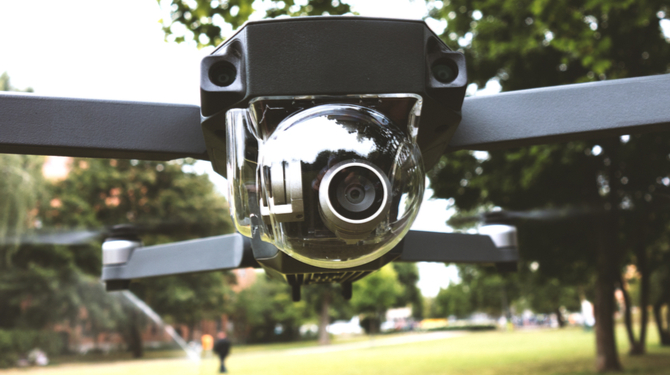CATUAV is one of the oldest UAV companies in Europe and has a core team of only six people. Recently the independent consultant Drone Industry Insights made a study comparing models
of drones across the globe. Five of CATUAV’s models featured in the top ten for the categories of 1-4kg and 4-25kg weight drone. They have also built their own drone testing centre – one of only ten in the world – with a bioclimatic and sustainable building, giving the ability to host their own piloting courses.
How has a company comprising only six people managed to compete globally?
I think the expected answer is about a unique business model, but instead it’s just about passion. If you are happy with the things you are doing you work more efficiently. We think we are more competitive than other potential competitors that are a hundred people strong just because of this passion that we have for designing our UAVs and providing our services.
It’s a case of having the right people; we've carefully chosen the people we want to have with us. Each of them is, for us, the best in those positions, giving us what we feel is a very competitive team.
Also our age is an advantage. We are one of the oldest UAV companies in Europe and a lot of competitors have three years’ experience at the most. Getting in at the start of a new technology gives you a real competitive edge and we are very fortunate in that regard. Our founder, who had been exploring the potential of UAVs in his spare time, was investigating their use
in an air field when the pilot of a landing jet plane was an executive of a company called Indra. After talking to the founder, he sawthe potential of UAVs and soon after a contract was signed to develop UAVs for Indra. Fortuitous circumstances to allow us to get an early start but we have capitalised on it.

Is there anything specific about Catalonia?
For flying drones, the weather and climatic conditions really matter. There are other centres in Finland, Denmark, Iceland, North Dakota; but in these areas you have fog, the principal enemy of UAVs. Here in Barcelona, we can fly for more than three hundred days throughout the year where we have excellent conditions with no wind and a lot of sun. These factors are hugely significant.
South Portugal is another place where a lot of companies get their piloting licences due to similar conditions. In northern latitudes you don’t have the same weather conditions to learn how to pilot effectively. Having a UAV test site close to the Mediterranean is a guarantee of having good weather and the availability of being able to fly for many days throughout the year.
Is Catalonia/Spain going to be a hotbed of development?
A few weeks ago, we held a meeting, supported by the Catalan government, where we put together all the principal actors in Catalonia that are dealing with drones. We were forty or fifty people representing different companies. It showcased how the area is fast becoming a hub in terms of UAVs; many new companies are being formed and there’s a rising degree of interest. We’re trying to coordinate with each other, so that we don’t repeat the things another company is doing, such as one company focussing on agriculture observations, another industrial management and so on.
We think competition is good but at some point it’s better to cooperate. If you’re competing you’re repeating things. If you’re cooperating it’s better for society in general. You’ve got all the necessities covered, it allows us to focus and get specialised in our areas, without having to dilute that specialism.

Is the regulation of UAVs suitable in Spain for your purposes?
So far it’s provisional and a bit too restrictive. It’s totally understandable due to it being a new technology that’s rising fast, so the government has to put in regulations quickly to avoid collisions in urban areas and so on. At present, there is a ceiling of 120m, you cannot fly further than 500m, you cannot fly above urban areas, at night, above a concentration of people and so on. And of course you need to have a licence.
The tendency is for it to be like the automotive industry: having certified cars, have licences, only driving certain places. The idea here is that this becomes a specialised service. Not everybody can or should fly these things with the same degree of regulation. Tomorrow, if you were to buy a phantom for personal use, you could be flying it over the city, and if you have never flown it before, it might be dangerous for the others. In specialised hands, under current regulation, that possibility for danger is greatly reduced.
What would you like to see happen with future regulation?
I would like, and I think it’s going to happen, that a common regulation agency or system will be established for the entirety of Europe. We’re within the European Union, it makes no sense that if you cross the border you face new regulations in terms of drones. So we will see something unified and a little less restrictive, but for the people who are specialised.
I want the law to become less restrictive for the specialised people and more restrictive for the hobbyists. It’s safer for everybody but also more productive for everybody. Designate a lot of places where the hobbyist can fly and are not endangering anyone as well as not running the risk of accidentally falling foul of the law. As a citizen, I wouldn’t want to see a cluster of drones fly near me and for the pilot to not know enough about how to operate them. As a specialist, I need to be able to pilot a UAV with a bit more freedom to maximise its potential.
What is your legal team like and what are their priorities?
We have one person who is an aerospace engineer. Unfortunately, he has to spend almost 80% of his time working here on complying with regulation; it’s becoming a little tedious really. Before an operation, he has to send emails saying we’re going to be flying here, with this model; even in our test site, we have to specify which models are flying and everything. It all requires a lot of groundwork. So we have one person out of six doing all that groundwork.
Will it expand? It depends on how many operations you are doing. If you have a lot of operations, you should be dealing directly with the safety arm of the Spanish aviation agency.
Is there enough specialist knowledge among lawyers?
It’s a big sector coming up. There are more and more drones coming up and people need to have insurance
for drones which differ a lot from the previous insurance. It’s something people don’t know about a lot yet, but it’s coming up. There will need to be an increase in the specialist knowledge so that the law can keep up with the technology.
Who are your main clients?
Our income comes from around the world, not just Spain. It’s a global market, there’s are so many different applications of drones everywhere. For example, Ecuador had a terrible earthquake recently, which wrecked communications. Nobody knew what exactly was happening and where. A picture from above facilitates the job of many people, helping the emergency services allocate their resources, as one example. In countries in Africa, there’s the application of looking for elephant hunters.
Our income is divided into three streams. The first segment is the services we provide: we fly for somebody and they pay for the maps and photos. The second segment is the drone flying courses that we host at our drone test centre. The third segment is the test site for people renting out our facilities for their own demonstrations.
In terms of clients in services, we have precision agriculture, landmine detection, the marine projects and many more. It’s a diverse client base, with the occasional governmental contract as they start to show more interest in this sector.
Is your client base likely to change in the future?
It’s going to expand a lot. According to the recent report by PwC, it will balloon up to $127 billion by 2020. We hope it’s going to increase and diversify our client base.
We were the early adopters and we feel that our experience will count for a lot when this sector undergoes a rapid expansion.

_Highly_Illuminated_streets.jpg)
.jpg)
.jpg)
.jpg)

.jpg)




